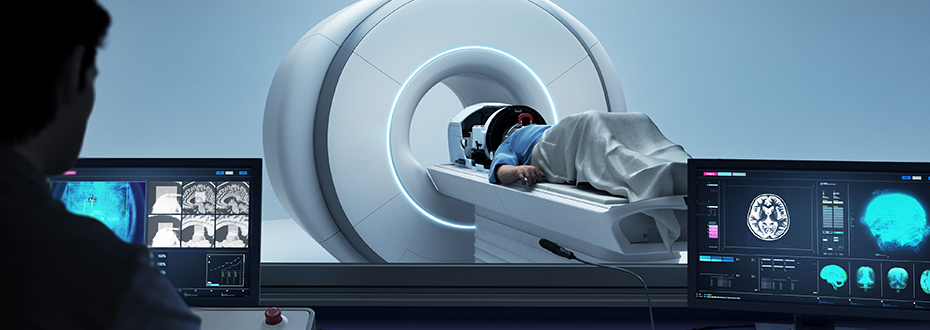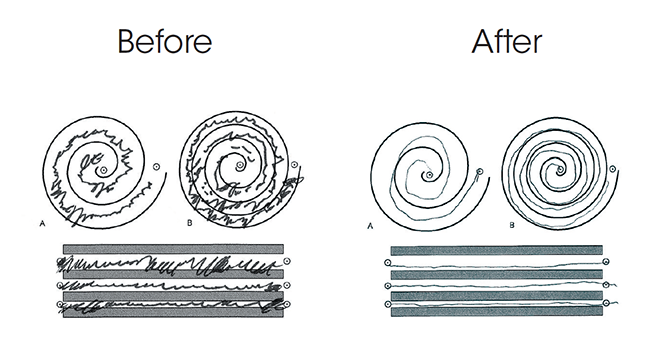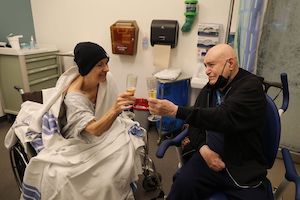High-Intensity Focused Ultrasound (HIFU)

OHSU is the only Oregon hospital to offer high-intensity focused ultrasound, or HIFU, for essential tremor and tremor-dominant Parkinson’s disease. This life-changing treatment improves tremor symptoms for most patients right away.
We can treat both sides of your body with bilateral focused ultrasound. You’ll have one side treated at a time, with at least nine months between sides.
We are the first in the country to use an enhanced version of focused ultrasound called Exablate Prime. It shortens the procedure to as little as 45 minutes and is more comfortable for you.
Benefits of focused ultrasound
Advanced, safer procedure: This treatment combines ultrasound with MRI. This means we can do surgery without cutting, while you’re awake. No cutting means no risk of problems like infection. Being awake means no anesthesia, and you see results in real time.
Better quality of life: Most patients get relief from tremor symptoms right away. In a study, more than 75% of patients still saw improvements three years later.
Quick recovery: Most patients return to daily activities within a day. Side effects (such as imbalance and numbness) usually stop within two to three weeks.
How does focused ultrasound work?
We use ultrasound to ablate (burn) the part of your brain that causes tremor. Using ultrasound means:
- No incisions: This technology lets us perform brain surgery without cuts. This means no risk of bruising, bleeding or infection.
- Precision: This technology lets us create a small lesion in the exact right place. More than 1,000 ultrasound waves come together in one spot that’s less than 2 to 3 millimeters, the size of a pen tip. This creates enough heat to cause a lesion.
- Instant feedback: Throughout the procedure, we test for improvement of your tremor symptoms so we know exactly when the procedure is done.
Side effects of focused ultrasound
Some patients notice mild side effects during and after treatment.
During:
- Sharp pain (10 to 20 seconds)
- Burning sensation
After:
- Imbalance or trouble walking
- Numbness and tingling in the fingers or around the mouth, lips or tongue
- Some loss of taste
- Headache
- Dizziness
- Scalp irritation
Limits of focused ultrasound
This treatment helps most patients, but it has limits.
- The treatment can vastly improve your tremor, but won’t stop it completely.
- This is not a cure. Essential tremor and Parkinson’s disease get worse over time and this treatment can’t stop that. You and your doctor can discuss if a second treatment with focused ultrasound is best for you. Or you can try another option like deep brain stimulation.
What to expect from focused ultrasound
Before treatment
- You’ll meet with one of our neurosurgeons and our patient coordinator to discuss the benefits and risks. We will assess your condition to make sure focused ultrasound is right for you.
- You’ll need an MRI and a CT scan.
Treatment day
- We shave your head so nothing blocks the ultrasound waves.
- You lie on a table that slides in and out of an MRI machine during the procedure.
- We use numbing medicine at four points on your scalp, then use pins to attach a frame. The frame holds your head still during the procedure.
- We fit you with a helmet-like device, filled with cool water, that has more than 1,000 ultrasound transmitters.
- We find a baseline by asking you to draw a spiral or touch your nose.
- We use a computer to see your brain and control the ultrasound waves.
- We start with a test lesion, a temporary change to make sure we are in the right place in your brain.
- The treatment lasts an hour to 90 minutes. Your entire visit lasts up to three hours. You go home that day.
- You return the next day for an MRI to evaluate the lesion and any swelling from excess fluid.
- You may have brain swelling in the treatment area for two to three weeks. This could cause imbalance or some instability in your dominant (stronger) leg.
- Your tremor symptoms improve during the procedure.

Is focused ultrasound right for you?
If your tremor is affecting your quality of life and medication isn’t helping, focused ultrasound may be an option for you.
This treatment works for patients who:
- Have a confirmed diagnosis of essential tremor or Parkinson’s-related tremor that does not respond to medication (such as propranolol or primidone).
- Do not want to have invasive brain surgery or commit to the ongoing adjustments that deep brain stimulation requires.
To schedule an evaluation for focused ultrasound treatment for essential tremor or tremor-dominant Parkinson’s disease:
- Call our clinic at 503-418-4775.
- Email us at focusedultrasound@ohsu.edu.
Our team
Neurosurgeons
-
- Ahmed M. Raslan, M.D., FAANS
- Accepting new patients
-
- Daniel Cleary, M.D., Ph.D. (he/him)
- Accepting new patients
Neuro-oncologists
-
- Sushant Puri, M.B.B.S. (he/him)
- Accepting new patients
Patient coordinator
-
- Christine J. Larsen, RN, B.S.N. (she/her)
- Accepting new patients
Frequently asked questions about focused ultrasound
If the treatment is relatively new, how do we know it’s safe?
Focused ultrasound was studied long before it was approved in 2016 to treat tremor in the United States.
Using ultrasound waves to create a brain lesion is a leading-edge technology, but it is based on decades-old medical science. Surgeons have lots of experience creating brain lesions with more invasive methods. They have used ultrasound waves in medicine for about 80 years.
Why do we use ultrasound waves?
The most important reason is that ultrasound uses no cuts (incisions). Focused ultrasound is brain surgery without an incision. No cutting means no risk of bruising, bleeding problems or infection.
What if the lesion ends up in the wrong place?
We have safety measures to make sure this can’t happen.
- A frame and helmet hold your head perfectly still.
- MRI gives us real-time images of your brain.
- Ultrasound waves create a lesion only where they come together. This focal point is smaller than 2 to 3 millimeters, the size of a pen tip.
- You are awake during the procedure, so we can monitor your symptom improvement and any problems.
- We first create a temporary lesion to make sure it’s in the right place before creating a permanent lesion.
Will it hurt?
Before the procedure, you will feel four needle pokes as we numb your scalp. During the procedure, some patients feel a sharp pain that usually lasts for 10 to 20 seconds. Some patients also feel a burning sensation.
Will my insurance pay for this treatment?
Focused ultrasound for tremor is covered by Medicare. If you don’t have Medicare, please contact your insurance company. Many private insurance companies cover this treatment.
Focused ultrasound versus deep brain stimulation
We will help you choose the right treatment for your tremor. Your wishes, type and severity of symptoms, and lifestyle goals are all important factors.
This chart compares the two treatment options we offer for essential tremor and tremor-dominant Parkinson’s disease.
| Focused ultrasound | Deep brain stimulation |
|---|---|
| Noninvasive with no incisions or risk of infection. | Two brain surgeries, each with incisions. |
| If you take blood thinners, you need to stop taking them for a few days. | If you take blood thinners, you need to stop taking them for one week. |
| No overnight hospital stay. | One-night hospital recovery for first surgery. No hospital stay for second surgery. |
| Can only treat one side. | Can treat both sides. |
| Whole head must be shaved. | Whole head must be shaved. |
| Results are immediate. You need one follow-up visit after treatment. | Follow-up visits are needed to program the implanted stimulator and make changes. |
| Lesion is permanent. | Stimulator implant can be turned off or removed. |
Learn more
Location
Center for Health & Healing Building 1, eighth floor
3303 S. Bond Ave.
Portland, OR 97239
Free parking for patients and visitors
For providers
- Refer your patient to OHSU.
- Call 503-494-4567 to seek provider-to-provider advice.
A HIFU pioneer

Read about Jean Henderson, the first tremor patient treated successfully with high-intensity focused ultrasound (HIFU) at OHSU. She and her husband celebrated with sparkling cider, and she held her glass steady for the first time in years.
HIFU helps an artist
Artist Carolyn Wilhelm was treated successfully with high-intensity focused ultrasound (HIFU) at OHSU. KGW8 reporter Brittany Falkers watched and wrote about the procedure.
A HIFU ‘miracle’
After having high-intensity focused ultrasound (HIFU) at OHSU, Rick Cranston calls the procedure “a miracle.” It stopped his decades-old tremor within a few hours.